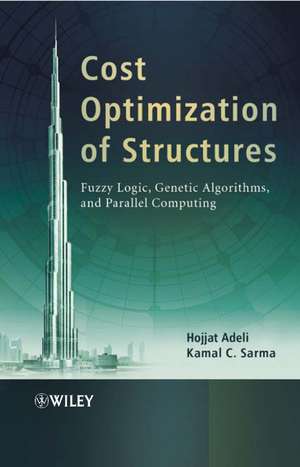Cost Optimization of Structures – Fuzzy Logic, Genetic Algorithms and Parallel Computing
Autor H Adelien Limba Engleză Hardback – 24 aug 2006
Preț: 535.98 lei
Preț vechi: 789.44 lei
-32% Nou
102.58€ • 106.81$ • 86.69£
Carte indisponibilă temporar
Specificații
ISBN-10: 0470867337
Pagini: 222
Dimensiuni: 162 x 236 x 18 mm
Greutate: 0.45 kg
Editura: Wiley
Locul publicării:Chichester, United Kingdom
Public țintă
This book will be of great interest to civil and structural engineers, mechanical engineers, computing engineers involved in cost optimization of structures and life–cycle cost optimisation; architectural engineers and graduate students in this field; software developers, researchers working in building design and structural optimization.Cuprins
Notă biografică
Hojjat Adeli is Professor of Civil and Environmental Engineering and Geodetic Science and Lichtenstein Professor in Infrastructure Engineering at The Ohio State University. A contributor to 70 different scholarly journals, he has authored over 400 research and scientific publications in diverse areas of engineering, computer science, and applied mathematics since he received his PhD from Stanford University in 1976 at the age of 26. He has authored/co-authored eleven pioneering books such as Machine Learning - Neural Networks, Genetic Algorithms, and Fuzzy Systems, John Wiley & Sons, Ltd, 1995; Neurocomputing for Design Automation, CRC Press, 1998; Distributed Computer-Aided Engineering, CRC Press, 1999; High-Performance Computing in Structural Engineering, CRC Press, 1999; Control, Optimization, and Smart Structures - High-Performance Bridges and Buildings of the Future, John Wiley & Sons, Ltd, 1999; Construction Scheduling, Cost Optimization, and Management - A New Model Based on Neurocomputing and Object Technologies, Spon Press, 2001; and Wavelets in Intelligent Transportation Systems, John Wiley & Sons, Ltd, 2005. He has also edited 12 books including Intelligent Information Systems, IEEE Computer Society, 1997. He is the Editor-in-Chief of two research journals, Computer-Aided Civil and Infrastructure Engineering, which he founded in 1986, and Integrated Computer-Aided Engineering, which he founded in 1993. He has been a Keynote/Plenary Lecturer at 56 international conferences held in 33 different countries and has served on the advisory/editorial/organizing board of 262 national and international conferences held in 55 different countries. On September 29, 1998, he was awarded a patent for a 'Method and apparatus for efficient design automation and optimization, and structures produced thereby' (United States Patent Number (5,815,394) (with a former PhD student). He is the recipient of numerous academic, research, and leadership awards, honors, and recognition. In 1998, he was awarded the University Distinguished Scholar Award by The Ohio State University 'in recognition of extraordinary accomplishment in research and scholarship' and the Senate of the General Assembly of the State of Ohio passed a resolution honoring him as an 'Outstanding Ohioan'. He is the quadruple winner of The Ohio State University College of Engineering Lumley Outstanding Research Award. In 2005 he was elected an Honorary Member of the American Society of Civil Engineers 'for wide-ranging, exceptional, and pioneering contributions to computing in many civil engineering disciplines and extraordinary leadership in advancing the use of computing and information technologies in civil engineering throughout the world'. In 2006 he was awarded The American Society of Civil Engineers' Construction Management Award 'for development of ingenious computational and mathematical models in the areas of construction scheduling, resource scheduling, and cost estimation'. His research has been sponsored by 20 different organizations including government funding agencies such as the National Science Foundation, US Air Force Flight Dynamics Laboratory, and US Army Construction Engineering Research Laboratory, Federal Highway Administration, state funding agencies such as the Ohio Department of Transportation, Ohio Department of Development, and the State of Ohio Research Challenge Program, professional societies such as the American Iron and Steel Institute and the American Institute of Steel Construction, and corporations such as Cray Research Inc., US Steel, and Bethlehem Steel Corporation.
Kamal C. Sarma is a Senior Bridge Engineer at Barr & Prevost in Columbus, Ohio. He is a registered Professional Engineer in the state of Ohio. He has more than 25 years of work experience in Civil and Structural Engineering and has designed numerous multi-span highway bridges in the state of Ohio. He obtained his Bachelor of Engineering degree in 1976 from Jorhat Engineering College in India and obtained his Master of Structural Engineering degree from University of Roorkee, India in 1984. He received his PhD in Civil Engineering from The Ohio State University in 2001. He worked as a Lecturer and an Assistant Professor in Assam Engineering College for 12 years where he taught courses on design of reinforced concrete and steel structures. As an expert consultant, the Government of Assam selected him as a member of a three-member committee assigned to investigate the development of cracks in the foundation of a thermal power station in Chandrapur, Assam, India. In the United States he also worked as a Senior Software Development Engineer for Qwest Communications and a Field Engineer for K&S Engineers in Highland, Indiana. He performed construction inspection of several multi-storied structures in the Chicago area. He has also consulted in the areas of geotechnical and foundation engineering including slurry wall construction. He is the co-author of 10 research articles in the areas of structural optimization, genetic algorithms, fuzzy systems, and high-performance computing including parallel processing, published in several international research journals.
